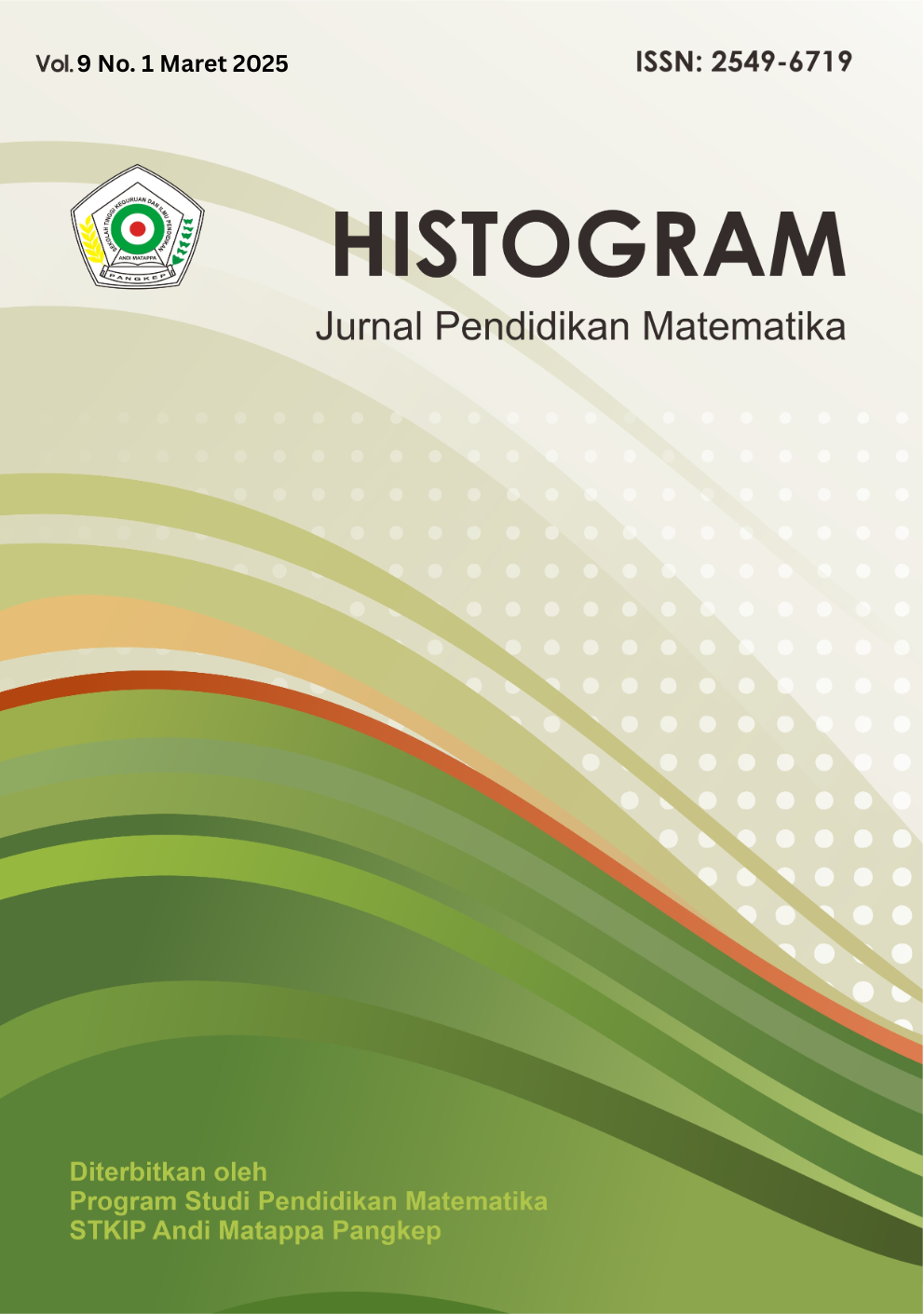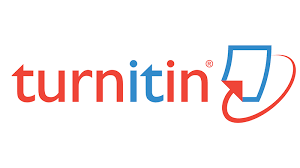Kemampuan Berpikir Komputasi pada Pembelajaran Geometri Berbasis Geogebra ditinjau dari Gaya Kognitif
DOI:
https://doi.org/10.31100/histogram.v9i1.4101Kata Kunci:
Berpikir Komputasi, Geometri, Gaya KognitifAbstrak
Kemampuan berpikir komputasi memegang peran penting diera revolusi 4.0 dalam pembelajaran matematika. Gaya kognitif mempengaruhi kemampuan pemecahan masalah siswa. Tujuan dari penelitian ini adalah mengetahui kemampuan berpikir komputasional dalam pembelajaran geometri berbasis Geogebra dari gaya kognitif field independent (FI) serta field dependent (FD). Penelitian memakai desain studi kasus dan metodologi kualitatif. Tiga puluh enam siswa dari kelas XI di SMA N 1 Boyolali berpartisipasi dalam penelitian ini. Soal tes, penilaian gaya kognitif, serta wawancara merupakan metode yang diterapkan untuk mengumpulkan data. Peneliti memilih satu siswa FI serta FD dengan kategori tinggi berdasarkan nilai tes dan kuesioner gaya kognitif. Menurut temuan, kemampuan siswa untuk bernalar secara komputasi dipengaruhi oleh perbedaan antara tipe kognitif FI dan FD. Sementara siswa FD hanya dapat memenuhi indikator pengenalan pola serta algoritma berpikir, siswa FI dapat memenuhi semua penanda berpikir komputasional, termasuk abstraksi, pengenalan pola, algoritma berpikir, juga generalisasi.
Referensi
Agoestanto, A., Sukestiyarno, Y. L., Isnarto, Rochmad, & Lestari, M. D. (2019). The Position and Causes of Students Errors in Algebraic Thinking Based on Cognitive Style. International Journal of Instruction, 12(1), 1431–1444. https://doi.org/10.29333/iji.2019.12191a
Aminah, N., Sukestiyarno, Y. L., Wardono, W., & Cahyono, A. N. (2022). Computational Thinking Process of Prospective Mathematics Teacher in Solving Diophantine Linear Equation Problems. European Journal of Educational Research, 11(3), 1495–1507. https://doi.org/10.12973/eu-jer.11.3.1495
Anggraeni, E. D., & Dewi, N. R. (2021). Kajian Teori: Pengembangan Bahan Ajar Matematika Berbantuan GeoGebra untuk Meningkatkan Kemampuan Pemecahan Masalah Matematis melalui Model Pembelajaran Preprospec Berbantuan TIK pada Materi Bangun Ruang Sisi Datar. PRISMA, Prosiding Seminar Nasional Matematika, 4, 179–188. https://journal.unnes.ac.id/sju/prisma/article/view/44959/18302
Ardi, S. D. K., & Masduki, M. (2023). Eksplorasi Berpikir Aljabar Siswa Kelas 5 dalam Menyelesaikan Soal Pemodelan. Jurnal Tadris Matematika, 6(1), 85–100. https://doi.org/10.21274/jtm.2023.6.1.85-100
Azahra, M., & Subekti, F. E. (2024). Kemampuan Pemecahan Masalah Matematis Berdasarkan Gaya Kognitif pada Siswa. Proximal: Jurnal Penelitian Matematika dan Pendidikan Matematika, 7(1), 475–484. https://doi.org/10.30605/proximal.v7i1.4117
Bintoro, H. S., Sukestiyarno, Y. L., Mulyono, & Walid. (2021). The Spatial Thinking Process of the Field-Independent Students Based on Action-Process-Object-Schema Theory. European Journal of Educational Research, 10(4), 1807–1823. https://doi.org/10.12973/EU-JER.10.4.1807
Bocconi, S., Chioccariello, A., & Earp, J. (2018). The Nordic Approach to Introducing Computational Thinking and Programming in Compulsory Education. https://doi.org/10.17471/54007
Buckley, J., Seery, N., & Canty, D. (2019). Investigating the Use of Spatial Reasoning Strategies in Geometric Problem Solving. International Journal of Technology and Design Education, 29(2), 341–362. https://doi.org/10.1007/s10798-018-9446-3
Clune, M. (2019). Computational Thinking in Primary Mathematics. Set: Research Information for Teachers, 3, 43–50. https://doi.org/10.18296/set.0151
Curzon, P., Bell, T., Waite, J., & Dorling, M. (2019) Computational Thinking. In S. A. Fincher & A. V. Robins (Eds.) The Cambridge Handbook of Computing Education Research. Cambridge University Press.
Elicer, R., Tamborg, A. L., Bråting, K., & Kilhamn, C. (2023). Comparing the Integration of Programming and Computational Thinking into Danish and Swedish Elementary Mathematics Curriculum Resources. Iron and Steel Technology, 11(3), 77–102. https://doi.org/10.31129/LUMAT.11.3.1940
Hanid, M. F. A., Said, M. N. H. M., Yahaya, N., & Abdullah, Z.. (2022). Effects of Augmented Reality Application Integration with Computational Thinking in Geometry Topics. Education and Information Technologies, 27(7), 9485-9521. https://doi.org/10.1007/s10639-022-10994-w
Juandi, D., Kusumah, Y. S., Tamur, M., Perbowo, K. S., & Wijaya, T. T. (2021). A Meta-Analysis of Geogebra Software Decade of Assisted Mathematics Learning: What to Learn and Where to Go? Heliyon, 7(5), e06953. https://doi.org/10.1016/j.heliyon.2021.e06953
Krogh, S., Annette, N., Bjerke, H., & Mifsud, L. (2022). Computational Thinking in the Primary Mathematics Classroom : a Systematic Review. Digital Experiences in Mathematics Education, 1, 27–49. https://doi.org/10.1007/s40751-022-00102-5
Lockwood, E., Asay, A., DeJarnette, A. F., & Thomas, M. (2016). Algorithmic Thinking: an Initial Characterization of Computational Thinking in Mathematics. 38th Annual Meeting of the North American Chapter of the International Group for the Psychology of Mathematics Education, 1588–1595.
Maharani, S., Agustina, Z. F., & Kholid, M. N. (2021). Exploring the Prospective Mathematics Teachers Computational Thinking in Solving Pattern Geometry Problem. AL-ISHLAH: Jurnal Pendidikan, 13(3), 1756–1767. https://doi.org/10.35445/alishlah.v13i3.1181
Masalimova, A. R., Mikhaylovsky, M. N., Grinenko, A. V., Smirnova, M. E., Andryushchenko, L. B., Kochkina, M. A., & Kochetkov, I. G. (2019). The Interrelation between Cognitive Styles and Copying Strategies among Student Youth. Eurasia Journal of Mathematics, Science and Technology Education, 15(4). https://doi.org/10.29333/ejmste/103565
Milicic, G., Wetzel, S., & Ludwig, M. (2020). Generic Tasks for Algorithms. Future Internet, 12(9), 152. https://doi.org/10.3390/fi12090152
Motahari, M. S., & Norouzi, M. (2015). The Difference between Field Independent and Field Dependent Cognitive Styles regarding Translation Quality. Theory and Practice in Language Studies, 5(11), 2373. https://doi.org/10.17507/tpls.0511.23
Muyassaroh, K. A., & Masduki, M. (2023). Profil Berpikir Aljabar Siswa dalam Menyelesaikan Permasalahan Generalisasi dan Berpikir Dinamis Ditinjau dari Gaya Kognitif FI-FD. FIBONACCI: Jurnal Pendidikan Matematika dan Matematika, 9(1), 27-42. https://doi.org/10.24853/fbc.9.1.27-42
Namli, N. A., & Aybek, B. (2022). An Investigation of The Effect of Block-Based Programming and Unplugged Coding Activities on Fifth Graders’ Computational Thinking Skills, Self-Efficacy and Academic Performance. Contemporary Educational Technology, 14(1), 1–16. https://doi.org/10.30935/cedtech/11477
Nuraida, N., Aripin, U., & Pereira, J. (2022). Students Mathematic Problem Solving Process in Two Variable Linear Equation Systems from Cognitive Field Dependent Style. IndoMath: Indonesia Mathematics Education, 5(1), 1-12. https://doi.org/10.30738/indomath.v5i1.17
OECD. (2019). PISA 2018 Results (Volume I): What Students Know and Can Do. OECD Publishing. https://doi.org/10.1787/5f07c754-en
Rejeki, S., & Rahmasari, L. (2022). Students’ Problem-Solving Ability in Number Patterns Topic Viewed from Cognitive Styles. Jurnal Elemen, 8(2), 587–604. https://doi.org/10.29408/jel.v8i2.5699
Rismen, S., Juwita, R., & Devinda, U. (2020). Profil Kemampuan Pemecahan Masalah Matematika Siswa Ditinjau dari Gaya Kognitif Reflektif. Jurnal Cendekia: Jurnal Pendidikan Matematika, 4(1), 163–171. https://doi.org/10.31004/cendekia.v4i1.159
Rowe, E., Asbell-Clarke, J., Baker, R., Gasca, S., Bardar, E., & Scruggs, R. (2018). Labeling Implicit Computational Thinking in Pizza Pass Gameplay. Extended Abstracts of the 2018 CHI Conference on Human Factors in Computing Systems. 1-6. https://doi.org/10.1145/3170427.3188541
Safitri, A., & Khotimah, R. P. (2023). Kemampuan Literasi Matematika Peserta Didik dalam Menyelesaikan Soal PISA Konten Space and Shape Ditinjau dari Gaya Kognitif. Jambura Journal of Mathematics Education, 4(1), 24–34. https://doi.org/10.34312/jmathedu.v4i1.18745
Selby, C., & Woollard, J. (2013). The Developing Concept of “Computational Thinking.” Informatics in Education, 1–3. http://eprints.soton.ac.uk/401033/1/161002TableofC%26CT.pdf
Sondakh, D. E., Osman, K., & Zainudin, S. (2020). A Proposal for Holistic Assessment of Computational Thinking for Undergraduate: Content Validity. European Journal of Educational Research, 9(1), 33–50. https://doi.org/10.12973/eu-jer.9.1.33
Sudia, M., & Lambertus. (2017). Profile of High School Student Mathematical Reasoning to Solve the Problem Mathematical Viewed from Cognitive Style. International Journal of Education and Research, 5(6), 163–174. https://www.ijern.com/journal/2017/June-2017/14.pdf
Sutama, S., Anif, S., Prayitno, H. J., Narimo, S., Fuadi, D., Sari, D. P., & Adnan, M. (2021). Metacognition of Junior High School Students in Mathematics Problem Solving Based on Cognitive Style. Asian Journal of University Education, 17(1), 134–144. https://doi.org/10.24191/ajue.v17i1.12604
Verawati, N. N. S. P., Hikmawati, Prayogi, S., & Bilad, M. R. (2021). Reflective Practices in Inquiry Learning: Its Effectiveness in Training Pre-Service Teachers’ Critical Thinking Viewed from Cognitive Styles. Jurnal Pendidikan IPA Indonesia, 10(4), 505–514. https://doi.org/10.15294/jpii.v10i4.31814
Zhang, Y. (2023). Defining Computational Thinking as an Evident Tool in Problem-Solving: Comparative Research on Chinese and Canadian Mathematics Textbooks. ECNU Review of Education, 6(4), 677–699. https://doi.org/10.1177/20965311231158393
Unduhan
Diterbitkan
Terbitan
Bagian
Citation Check
Lisensi
Hak Cipta (c) 2025 Yulia Maftuhah Hidayati, Berliani Ardelia Sukowati, Windi Hastuti, Sukimin

Artikel ini berlisensi Creative Commons Attribution-NonCommercial-NoDerivatives 4.0 International License.
Please find the rights and licenses in Histogram: Jurnal Pendidikan Matematika. By submitting the article/manuscript, the author(s) accept this policy.
1. License
The non-commercial use of the article will be governed by the Creative Commons Attribution license as currently displayed on Creative Commons Attribution-ShareAlike 4.0 International.
2. Author's Warranties
The author warrants that the article is original, written by a stated author(s), has not been published before, contains no unlawful statements, does not infringe the rights of others, is subject to copyright that is vested exclusively in the author and free of any third party rights, and that any necessary written permissions to quote from other sources have been obtained by the author(s).
3. User Rights
Histogram: Jurnal Pendidikan Matematika's spirit is to disseminate articles published for free. Under the Creative Commons license, Histogram: Jurnal Pendidikan Matematika permits users to copy, distribute, display, and perform the work for non-commercial purposes only. Users will also need to attribute authors and Histogram: Jurnal Pendidikan Matematika when distributing works in the journal.
4. Rights of Authors
Authors retain all their rights to the published works, such as (but not limited to) the following rights;
- Copyright and other proprietary rights relating to the article, such as patent rights,
- The right to use the substance of the article in one's future works, including lectures and books,
- The right to reproduce the article for one's purposes,
- The right to self-archive the article,
- The right to enter into separate, additional contractual arrangements for the non-exclusive distribution of the article's published version (e.g., post it to an institutional repository or publish it in a book), with an acknowledgment of its initial publication in this journal (Histogram: Jurnal Pendidikan Matematika).
5. Co-Authorship
If other authors jointly prepared the article, any author submitting the manuscript warrants that all co-authors have authorized them to agree on this copyright and license notice (agreement) on their behalf and agree to inform their co-authors of the terms of this policy. Histogram: Jurnal Pendidikan Matematika will not be held liable for anything arising from the author(s) internal dispute. Histogram: Jurnal Pendidikan Matematika will only communicate with the corresponding author.
6. Royalties
This agreement entitles the author to no royalties or other fees. To such an extent that it is legally permissible, the author waives their right to collect royalties relative to the article regarding any use by Histogram: Jurnal Pendidikan Matematika.
7. Miscellaneous
Histogram: Jurnal Pendidikan Matematika will publish the article (or have it published) in the journal if the editorial process is completed. Histogram: Jurnal Pendidikan Matematika h editors may modify the article to a style of punctuation, spelling, capitalization, referencing, and usage that deems appropriate. The author acknowledges that the article may be published to be publicly accessible, and such access will be free of charge for the readers, as mentioned in point 3.





